Excerpts from Jim Conrad's
Naturalist Newsletter
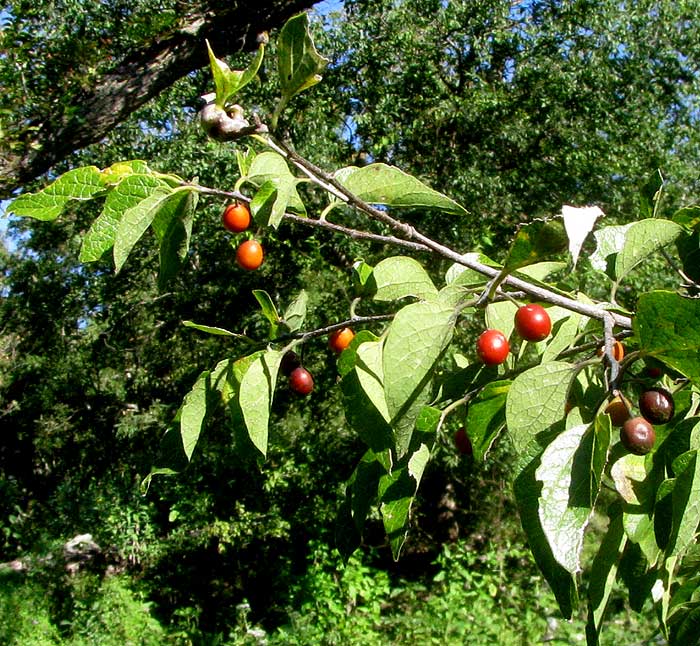
from the the September 30, 2012 Newsletter issued from the valley of the Dry Frio River in northern Uvalde County, southwestern Texas, on the southern border of the Edwards Plateau; elevation ~1750m (~5750 ft); N29.62°, W99.86°; USA
NETLEAF HACKBERRY
On rocky limestone outcrops hemming in the little Dry Frio River nowadays you see medium-sized trees loaded with pea-sized, red fruits, as shown above.
The small fruits are drupes, which means that they are fleshy, one-seeded fruits that do not split open at maturity, and that the seeds are enclosed in a woody shell, the endocarp. Such hard-shelled seeds are often called stones. Cherries, plums and peaches are drupes with stone-type seeds. The red fruits in the picture are surprisingly sweet and tasty, though the flesh covering the seeds is so meager that most people wouldn't bother nibbling on them. Of course birds eat great quantities of them. You can see some fruits and their seeds close up below:
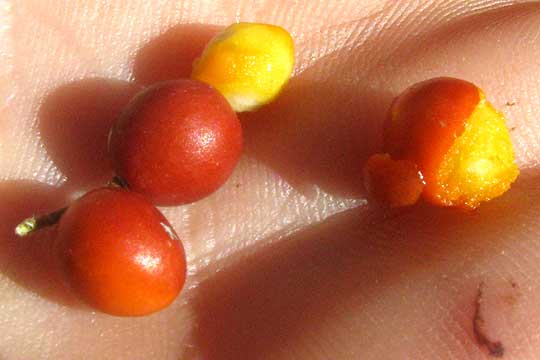
The tree's very warty bark is shown below:
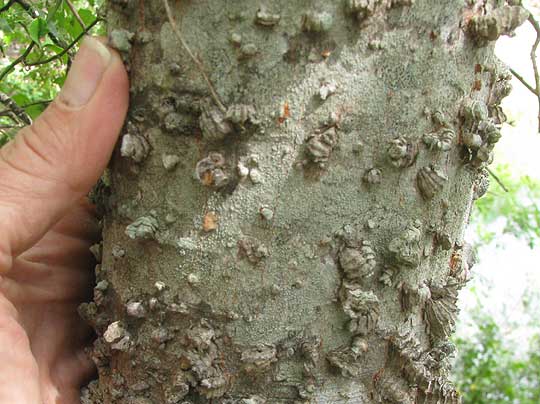
If you know your trees you probably recognize that this is some kind of hackberry or sugarberry, but which one? North America is home to six hackberry/sugarberry species -- members of the genus Celtis -- and sometimes distinguishing them can be hard. Also, several Celtis species hybridize, and in general Celtis taxonomy is in a mess.
However, the red fruits and the 1¾-inch long leaves (4.5cm) -- unusually small for a hackberry/sugarberry -- with their smooth margins lacking serrations, and with the blades' pronounced netlike venation, all are good field marks helping us identify this as the Netleaf Hackberry, sometimes called the Western Hackberry, Canyon Hackberry and Palo Blanco. It's CELTIS RETICULATA, mostly distributed in the arid southwestern US, though in the mountains it extends as far north as southeastern Washington state.
Birds, squirrels, foxes, coyotes, and other mammals eat the sweet fruits, and White-tailed Deer and cattle out on the range browse the leaves and young stems. The USDA rates Netleaf Hackberry browse as a good source of protein.
from the March 24, 2013 Newsletter issued from the valley of the Dry Frio River in northern Uvalde County, southwestern Texas, on the southern border of the Edwards Plateau; elevation ~1750m (~5750 ft); N29.62°, W99.86°; USA
NETLEAF HACKBERRY FLOWERING
Nowadays the Netleaf Hackberry is flowers. A close-up of a shoot freshly emerged from a twig's terminal bud is seen below:
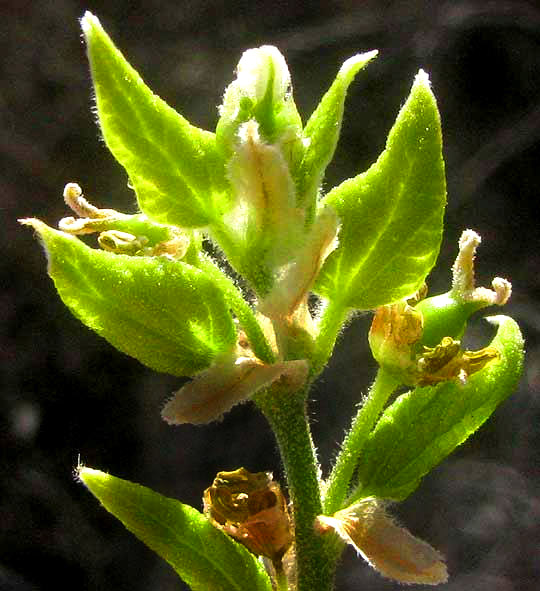
There you can see the hackberry's leaves nicely three-veined from the blade base the way a hackberry leaf should be. At the base of each leaf petiole arises a whitish, tongue-shaped, leaf-like stipule, which more or less embraces the embryonic leaf and flowers, protecting them from the elements during their most vulnerable time. Single flowers arise in angles formed where the petioles attach to the stem. Each flower consists of a shiny, pear-shaped, green ovary topped by two white, fuzzy, rabbit-ear-like styles. Pollen lands on the styles' fuzzy parts -- the "stigmatic" areas -- germinates, and the male sex germ migrates in a pollen tube from the pollen grain through the styles into the ovules inside the ovary. The ovary becomes the future fruit while ovules mature into seeds. In the flowers in the picture, below the green ovaries you can see the withered male parts -- yellow-brown anthers, which already have shed their pollen.
Curiously, flowers lower down the freshly emerged, elongating branch sprouts often are strictly male -- ovaries are missing and there are only stamens consisting of whitish, fingerlike filaments topped with greenish anthers. A picture showing a female flower with its white, rabbit-ear styles in the top, left corner, and a flower with only five stamens in the lower, right corner, is seen below:
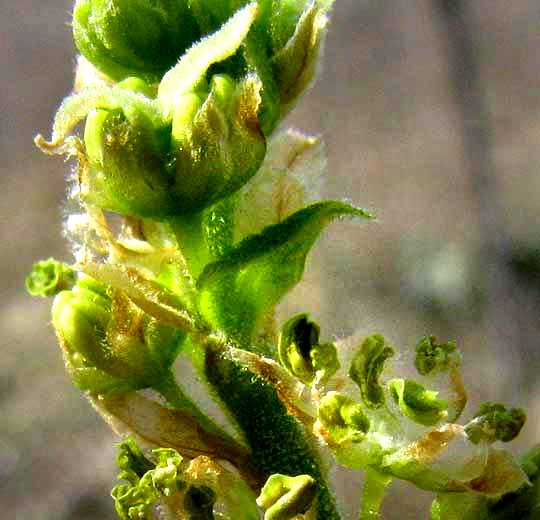
Netleaf Hackberries are very similar to the southeast US's Sugarberry trees. In fact, earlier Netleaf Hackberries were regarded as mere varieties of the Sugarberry, and sometimes it can be hard to distinguish the two species. Both species are to be found in this area. However, Netleaf Hackberry's new stems, its flower pedicels and leaf petioles all bear soft, white, wooly hairs, while the same newly emerged parts of the Sugarberry usually are not nearly so hairy. They may be somewhat hairy, but that hairiness soon disappears, and is not as conspicuous as shown in our pictures.
By the way, last September we were eating the Netleaf Hackberry's sweet, red drupes. Now in March many trees still bear numerous fruits, though now they are brown. However, they are still sweet, and I can't pass a tree without sampling a few. It's a mystery to me why the area's birds have not consumed them all.